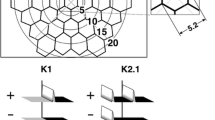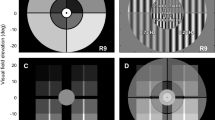Abstract
Background
Previous studies have shown significant age-related changes in the first-order kernel of multifocal ERG (mfERG) responses. All of these reports were based upon ring averages across the retinal field. This study was carried out to determine age-related changes in the localized response and localized variability in the mfERG parameters: N1P1 amplitude, scalar product and implicit time of P1.
Methods
MfERG recordings from 70 normal phakic subjects (ages 9–80 years) were analyzed with VERIS 4.8. Scalar product values (for each hexagon based on ring average templates) were obtained and analyzed for age-related changes. Statistical measures such as coefficient of variation (CV) and parameters of a linear regression model were applied. Point-by-point comparisons were made across hemifields.
Results
Each localized response showed a significant aging effect either in scalar product or in N1P1 amplitude. The average decline of the response was ~5% per decade, varying from 3.3% (peripherally) to 7.5% (perifoveally). The decline was significantly higher for the superior than for the inferior retina for amplitude parameters, corresponding to larger increases in P1 implicit time. The relative rate of change with age was similar for the nasal and the temporal retina. The average CV for all subjects at all locations was 29.4% (±4.1%).
Conclusions
The localized approach revealed patterns of age-related change that were not apparent in the ring averages. Information about changes in discrete retinal areas with age should make the mfERG more useful in quantitatively monitoring progression of retinal disease.







Similar content being viewed by others
References
Anderson RS, McDowell DR (1997) Peripheral resolution using stationary and flickering gratings: the effects of age. Curr Eye Res 16:1209–1214
Birch DG, Anderson JL (1992) Standardized full-field electroretinography. Normal values and their variation with age. Arch Ophthalmol 110:1571–1576
Birch DG, Hood DC, Locke KG, Hoffman DR, Tzekov RT (2002) Quantitative electroretinogram measures of phototransduction in cone and rod photoreceptors: normal aging, progression with disease, and test-retest variability. Arch Ophthalmol 120:1045–1051
Bird AC, Bressler NM, Bressler SB, Chisholm IH, Coscas G, Davis MD, de Jong PT, Klaver CC, Klein BE, Klein R, et al (1995) An international classification and grading system for age-related maculopathy and age-related macular degeneration. The International ARM Epidemiological Study Group. Surv Ophthalmol 39:367–374
Buck SL (2004) Rod-cone interactions in human vision. In: Chalupa, L. M., Werner, J. S. (eds) The visual neurosciences MIT Press Cambridge, MA 863–878
Chung HS, Harris A, Halter PJ, Kagemann L, Roff EJ, Garzozi HJ, Hosking SL, Martin BJ (1999) Regional differences in retinal vascular reactivity. Invest Ophthalmol Vis Sci 40:2448–2453
Cogan DG (1963) Development and senescence of the human retinal vasculature. Trans Ophthalmol Soc UK 83:465
Cooper RL, Eikelboom RH, Barry CJ (1992) Correlations between densitometry of red-free photographs and reflectometry with the scanning laser ophthalmoscope in normal subjects and glaucoma patients. Int Ophthalmol 16:243–246
Curcio CA, Allen KA (1990) Topography of ganglion cells in human retina. J Comp Neurol 300:5-25
Curcio CA, Drucker DN (1993) Retinal ganglion cells in Alzheimer’s disease and aging. Ann Neurol 33:248–257
Curcio CA, Sloan KR, Jr., Packer O, Hendrickson AE, Kalina RE (1987) Distribution of cones in human and monkey retina: individual variability and radial asymmetry. Science 236:579–582
Curcio CA, Sloan KR, Kalina RE, Hendrickson AE (1990) Human photoreceptor topography. J Comp Neurol 292:497–523
Curcio CA, Millican CL, Allen KA, Kalina RE (1993) Aging of the human photoreceptor mosaic: evidence for selective vulnerability of rods in central retina. Invest Ophthalmol Vis Sci 34:3278–3296
Dallinger S, Findl O, Strenn K, Eichler HG, Wolzt M, Schmetterer L (1998) Age dependence of choroidal blood flow. J Am Geriatr Soc 46:484–487
Delori FC, Goger DG, Dorey CK (2001) Age-related accumulation and spatial distribution of lipofuscin in RPE of normal subjects. Invest Ophthalmol Vis Sci 42:1855–1866
Fitzgerald ME, Tolley E, Frase S, Zagvazdin Y, Miller RF, Hodos W, Reiner A (2001) Functional and morphological assessment of age-related changes in the choroid and outer retina in pigeons. Vis Neurosci 18:299–317
Fortune B, Johnson CA (2002) Decline of photopic multifocal electroretinogram responses with age is due primarily to preretinal optical factors. J Opt Soc Am A Opt Image Sci Vis 19:173–184
Garway-Heath DF, Poinoosawmy D, Fitzke FW, Hitchings RA (2000) Mapping the visual field to the optic disc in normal tension glaucoma eyes. Ophthalmology 107:1809–1815
Gerth C, Garcia SM, Ma L, Keltner JL, Werner JS (2002) Multifocal electroretinogram: age-related changes for different luminance levels. Graefe’s Arch Clin Exp Ophthalmol 240:202–208
Gerth C, Hauser D, Delahunt PB, Morse LS, Werner JS (2003) Assessment of multifocal electroretinogram abnormalities and their relation to morphologic characteristics in patients with large drusen. Arch Ophthalmol 121:1404–1414
Gerth C, Sutter EE, Werner JS (2003) MfERG response dynamics of the aging retina. Invest Ophthalmol Vis Sci 44:4443–4450
Groh MJ, Michelson G, Langhans MJ, Harazny J (1996) Influence of age on retinal and optic nerve head blood circulation. Ophthalmology 103:529–534
Harman A, Abrahams B, Moore S, Hoskins R (2000) Neuronal density in the human retinal ganglion cell layer from 16–77 years. Anat Rec 260:124–131
Healey PR, Mitchell P, Smith W, Wang JJ (1997) The influence of age and intraocular pressure on the optic cup in a normal population. J Glaucoma 6:274–278
Hood DC (2000) Assessing retinal function with the multifocal technique. Prog Retin Eye Res 19:607–646
Ito YN, Mori K, Young-Duvall J, Yoneya S (2001) Aging changes of the choroidal dye filling pattern in indocyanine green angiography of normal subjects. Retina 21:237–242
Jackson GR, Ortega J, Girkin C, Rosenstiel CE, Owsley C (2002) Aging-related changes in the multifocal electroretinogram. J Opt Soc Am A Opt Image Sci Vis 19:185–189
Jonas JB, Schmidt AM, Muller-Bergh JA, Schlotzer-Schrehardt UM, Naumann GO (1992) Human optic nerve fiber count and optic disc size. Invest Ophthalmol Vis Sci 33:2012–2018
Jonas JB, Schneider U, Naumann GO (1992) Count and density of human retinal photoreceptors. Graefes Arch Clin Exp Ophthalmol 230:505–510
Kanai K, Abe T, Murayama K, Yoneya S (2002) [Retinal thickness and changes with age]. Nippon Ganka Gakkai Zasshi 106:162–165
Laatikainen L, Larinkari J (1977) Capillary-free area of the fovea with advancing age. Invest Ophthalmol Vis Sci 16:1154–1157
Lam AK, Chan ST, Chan H, Chan B (2003) The effect of age on ocular blood supply determined by pulsatile ocular blood flow and color Doppler ultrasonography. Optom Vis Sci 80:305–311
Lovasik JV, Kergoat MJ, Justino L, Kergoat H (2003) Neuroretinal basis of visual impairment in the very elderly. Graefes Arch Clin Exp Ophthalmol 241:48–55
Marmor MF (2002) “Do you, doctor, take the mfERG for better or for worse?” Graefes Arch Clin Exp Ophthalmol 240:241–243
Marmor MF, Hood DC, Keating D, Kondo M, Seeliger MW, Miyake Y (2003) Guidelines for basic multifocal electroretinography (mfERG). Doc Ophthalmol 106:105–115
Mata NL, Tzekov RT, Liu X, Weng J, Birch DG, Travis GH (2001) Delayed dark-adaptation and lipofuscin accumulation in abcr+/- mice: implications for involvement of ABCR in age-related macular degeneration. Invest Ophthalmol Vis Sci 42:1685–1690
Mohidin N, Yap MK, Jacobs RJ (1999) Influence of age on the multifocal electroretinography. Ophthalmic Physiol Opt 19:481–488
Nabeshima T, Tazawa Y, Mita M, Sano M (2002) Effects of aging on the first and second-order kernels of multifocal electroretinogram. Jpn J Ophthalmol 46:261–269
Nagatomo A, Nao-i N, Maruiwa F, Arai M, Sawada A (1998) Multifocal electroretinograms in normal subjects. Jpn J Ophthalmol 42:129–135
Panda-Jonas S, Jonas JB, Jakobczyk-Zmija M (1995) Retinal photoreceptor density decreases with age. Ophthalmology 102:1853–1859
Panda-Jonas S, Jonas JB, Jakobczyk-Zmija M (1996) Retinal pigment epithelial cell count, distribution, and correlations in normal human eyes. Am J Ophthalmol 121:181–189
Parks S, Keating D, Williamson TH, Evans AL, Elliott AT, Jay JL (1996) Functional imaging of the retina using the multifocal electroretinograph: a control study. Br J Ophthalmol 80:831–834
Penrose PJ, Tzekov RT, Sutter EE, Fu AD, Allen AW, Jr., Fung WE, Oxford KW (2003) Multifocal electroretinography evaluation for early detection of retinal dysfunction in patients taking hydroxychloroquine. Retina 23:503–512
Pierscionek BK, Weale RA (1996) Risk factors and ocular senescence. Gerontology 42:257–269
Quigley HA, Brown AE, Morrison JD, Drance SM (1990) The size and shape of the optic disc in normal human eyes. Arch Ophthalmol 108:51–57
Rojanapongpun P, Drance SM (1993) Velocity of ophthalmic arterial flow recorded by Doppler ultrasound in normal subjects. Am J Ophthalmol 115:174–180
Seeliger MW, Kretschmann UH, Apfelstedt-Sylla E, Zrenner E (1998) Implicit time topography of multifocal electroretinograms. Invest Ophthalmol Vis Sci 39:718–723
Seiple W, Vajaranant TS, Szlyk JP, Clemens C, Holopigian K, Paliga J, Badawi D, Carr RE (2003) Multifocal electroretinography as a function of age: the importance of normative values for older adults. Invest Ophthalmol Vis Sci 44:1783–1792
Sing NM, Anderson SF, Townsend JC (2000) The normal optic nerve head. Optom Vis Sci 77:293–301
Sjostrand FS (2002) Sequential pictorial presentation of neural interaction in the retina. 2. The depolarizing and hyperpolarizing bipolar cells at rod terminals. J Submicrosc Cytol Pathol 34:85–98
Sjostrand FS (2003) Color vision at low light intensity, dark adaptation, Purkinje shift, critical flicker frequency and the deterioration of vision at low illumination. Neurophysiology at the nanometer range of neural structure. J Submicrosc Cytol Pathol 35:117–127
Sugi K (1966) Studies on the pathological changes in the retinal vessels of human eyes, using the trypsin digestion method. Jpn J Ophthalmol 10:252
Sutter EE (1991) The fast m-transform: a fast computation of cross-correlations with binary m-sequences. SIAM J Comput 20:686–694
Sutter EE, Tran D (1992) The field topography of ERG components in man--I. The photopic luminance response. Vision Res 32:433–446
Suzuki S, Horiguchi M, Tanikawa A, Miyake Y, Kondo M (1998) Effect of age on short-wavelength sensitive cone electroretinogram and long- and middle-wavelength sensitive cone electroretinogram. Jpn J Ophthalmol 42:424–430
Watzke RC, Soldevilla JD, Trune DR (1993) Morphometric analysis of human retinal pigment epithelium: correlation with age and location. Curr Eye Res 12:133–142
Weleber RG (1981) The effect of age on human cone and rod ganzfeld electroretinograms. Invest Ophthalmol Vis Sci 20:392–399
Weng J, Mata NL, Azarian SM, Tzekov RT, Birch DG, Travis GH (1999) Insights into the function of Rim protein in photoreceptors and etiology of Stargardt’s disease from the phenotype in abcr knockout mice. Cell 98:13–23
Wikler KC, Williams RW, Rakic P (1990) Photoreceptor mosaic: number and distribution of rods and cones in the rhesus monkey retina. J Comp Neurol 297:499–508
Williams TD, Wilkinson JM (1992) Position of the fovea centralis with respect to the optic nerve head. Optom Vis Sci 69:369–377
Yoshii M, Paarmann A (1989) Hemiretinal stimuli elicit different amplitudes in the pattern electroretinogram. Doc Ophthalmol 72:21–30
Acknowledgement
We appreciate the technical assistance of Susan Garcia, Lei Ma and Lawrence Morse. This work was funded by the National Institute on Aging (AG04058) and a Jules and Doris Stein Research to Prevent Blindness Professorship.
Author information
Authors and Affiliations
Corresponding author
Additional information
Commercial interest: none
Rights and permissions
About this article
Cite this article
Tzekov, R.T., Gerth, C. & Werner, J.S. Senescence of human multifocal electroretinogram components: a localized approach. Graefe's Arch Clin Exp Ophthalmol 242, 549–560 (2004). https://doi.org/10.1007/s00417-004-0892-0
Received:
Revised:
Accepted:
Published:
Issue Date:
DOI: https://doi.org/10.1007/s00417-004-0892-0




